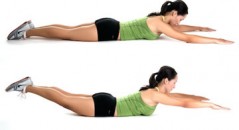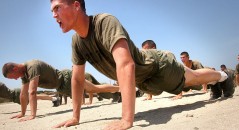 These exercises for pregnant women are designed to help mothers-to-be build strength in critical areas. There are many benefits to working out while pregnant. Mothers who choose to workout during pregnancy tend to feel better, have easier deliveries and healthier babies.
These exercises for pregnant women are designed to help mothers-to-be build strength in critical areas. There are many benefits to working out while pregnant. Mothers who choose to workout during pregnancy tend to feel better, have easier deliveries and healthier babies.
Every pregnancy is different and you should always consult your doctor before starting a fitness routine. Many pregnant women will find that these exercises will help them avoid aches and pains while keeping them independent late into their pregnancy.
4 exercises for pregnant women
Many core exercises like crunches and front planks are not well suited for the 2nd and 3rd trimester because they could increase your risk of a diastasis recti. A diastasis recti is a separation of you abdominal muscles. Instead of doing traditional core exercises try diaphragmatic breathing or the Palof press. Anti-rotational exercises like the Palof press will strengthen your core and help with balance- something pregnant women struggle with as their bodies change.
Pallof press
- Affix the band to an immovable object at chest level.
- Stand inline with the band so that your body is parallel to the anchor point.
- Hold the band with both hands and center it on your chest. Do not allow the band to rotate your upper body.
- Exhale, push the band straight out in front of you, brace your core and glutes to resist the urge to rotate.
- Hold your arms out for 3 seconds, then return the band to your chest.
As their breast become fuller and heavier, many pregnant women will adopt a forward sloping posture. When you allow your shoulders to fall forward and your chest to cave in the spine is put into a compromised position. Over time this bad positioning could lead to low back pain. Strengthening your upper-back with exercises like the row can counteract the extra load you’re carrying up front and keep your posture correct.
Band resisted row
- Find a fixed object where you can wrap the exercise band around
- Garb an end of the band in each hand an step back to were the band is under tension
- Stand with your feet apart, shoulder width
- Exhale, keep your elbows close to your sides as you pull the band towards you.
- Contract and flex your back muscles at the peak position
- Inhale as you return to starting position slowly.
- Repeat for the recommended number of reps.
As you approach your due date standing up and siting down on your own might become challenging. Including squats in your workout can help you avoid the embarrassment of getting stuck on the couch. In fact, many women choose to squat while giving birth because the position allows your body to work with gravity as you push your baby into the world.
Bodyweight Squat
- Stand with your feet beneath your shoulders.
- Push your feet into the ground like you’re trying to split apart the floor beneath you: this will help engage your glutes.
- Inhale and lower your body like you’re sitting down in a chair. Keep the back neutral, chest up and core engaged.
- Lower your body until your thighs are at least parallel to the ground.
- Keep your torso stiff as you exhale and press your body back up to standing.
Strong glute muscles will help you keep the pelvis in good alignment throughout your pregnancy. Good alignment will give your baby the room it needs to grow and get into the correct position for birth. Strong glutes will also help you support your back and hopefully avoid pregnancy related back pain. The bodyweight hip thrust is an excellent exercise for the glutes.
Hip thrusts
- Sit on the floor with your back against one side of a bench with your shoulder blades hooked onto the edge, arms reaching out to the sides, and knees bent to a 90 degree angle.
- Exhale, press your feet into the ground, squeeze your glutes as tight as you can and raise the hips up so you create a straight line from your knees to shoulders.
- Be very careful not to arch your lower back into hyper-extension. Focus on keeping your ribcage and your pelvis tucked towards one another throughout the exercise.
- Inhale, lower the hips down towards the floor as you raise your upper body up, and return to the starting position.
photo by Swangerschaft




